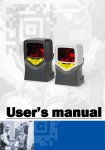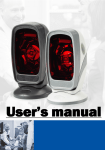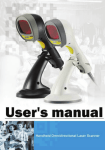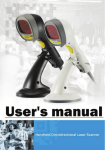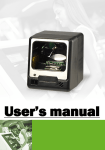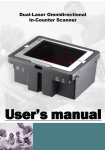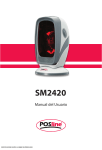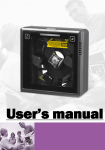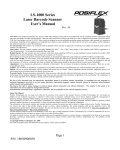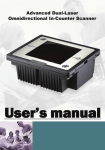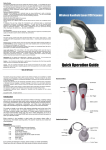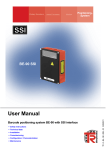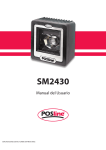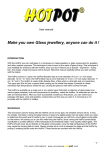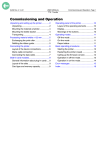Download User`s Manual_Z-3060_100519
Transcript
1 2 No warranty of any kind is made in regard to this material, including, but not limited to, implied warranties of merchantability or fitness for a particular purpose. We are not liable for any errors contained herein or incidental or consequential damages in connection with furnishing, performance or use of this material. No part of this document may be reproduced, transmitted, stored in a retrieval system, transcribed, or translated into any language or computer language in any form or by any means electronic, mechanical, magnetic, optical, chemical, manual or otherwise, without express written consent and authorization. We reserve the right to make changes in product design without reservation and without notification. The material in this guide is for information only and is subject to change without notice. All trademarks mentioned herein, registered or otherwise, are the properties of their various respective owners. Copyright © 2008. All rights reserved. Radio Notice This equipment generates uses and can radiate radio frequency energy. If not installed and used in accordance with the instructions in this manual, it may cause interference to radio communications. The equipment has been tested and found to comply with the limits for a Class A computing device pursuant to EN55022 and 47 CFR, Part 2 and Part 15 of the FCC rules. These specifications are designed to provide reasonable protection against interference when operated in a commercial environment. Radio and Television Interference Operation of this equipment in a residential area can cause interference to radio or television reception. This can be determined by turning the equipment off and on. The user is encouraged to try to correct the interference by one or more of the following measures: Reorient the receiving antenna. Relocate the device with respect to the receiver. Move the device away from the receiver. Plug the device into a different outlet so that the device and the receiver are on different branch circuits. If necessary the user may consult the manufacturer, and authorized dealer, or experienced radio/television technician for additional suggestions. The user may find the following booklet prepared by the Federal Communications Commission helpful: “How to Identify and Resolve Radio-TV Interference Problems.” This booklet is available from the U.S. Government Printing Office, Washington, DC 20402 U.S.A., Stock No. 004000003454. For CE-countries This scanner is in conformity with CE standards. Please note that an approved, CE-marked power supply unit should be used in order to maintain CE conformance. i Laser Safety The laser scanner complies with safety standard IEC 60825 -1for a Class I laser produce. It also complies with CDRH as applicable to a Class IIa laser product. Avoid long term staring into direct laser light. Radiant Energy: The laser scanner uses one low-power visible laser diodes operating at 650nm in an opto-mechanical scanner resulting in less than 3.9µW radiated power as observed through a 7mm aperture and averaged over 10 seconds. Do not attempt to remove the protective housing of the scanner, as unscanned laser light with a peak output up to 0.8mW would be accessible inside. Laser Light Viewing: The scan window is the only aperture through which laser light may be observed from this product. A failure of the scanner motor, while the laser diode continues to emit a laser beam, may cause emission levels to exceed those for safe operation. The scanner has safeguards to prevent this occurrence. If, however, a stationary laser beam is emitted, the failing scanner should be disconnected from its power source immediately. Adjustments: Do not attempt any adjustments or alteration of this product. Do not remove the protective housing of the scanner. There are no user-serviceable parts inside. Optical: The use of optical instruments with this product will increase the eye hazard. Optical instruments include binoculars, magnifying glasses, and microscopes but do not include normal eye glasses worn by the user. CAUTION: Use of controls or adjustments or performance of procedures other than those specified herein may result in hazardous radiation exposure. ii Table of Contents Introduction........................................................................................... 1 Unpacking............................................................................................. 2 Outline .................................................................................................. 3 Scanner Outline ........................................................................... 4 Stand Outline ............................................................................... 4 Connecting ........................................................................................... 5 Power........................................................................................... 5 Verifying Scanner Operation........................................................ 5 Connecting to the Host ................................................................ 6 Setting Up the Scanner ........................................................................ 7 Scan Test ..................................................................................... 7 Set up........................................................................................... 7 Operating the Scanner ......................................................................... 9 Function Button............................................................................ 9 Presentation Mode............................................................ 9 Multi-line Scan Mode ...................................................... 10 Single-line Scan Mode .................................................... 10 LED Indications...........................................................................11 Beeps .........................................................................................11 Sleep Mode................................................................................ 12 Maintaining the Scanner..................................................................... 13 Troubleshooting.................................................................................. 14 iii 1. Instruction The scanner, combining with omnidirectional scanning performance and handheld convenience, it is ergonomically facilitates scanning of large items that is unable to be presented to any counter-top scanner. It is also equipped with single line scanning capability and in stand operation with exclusively designed adjustable stand to benefit for any kind of applications required. The scanner has a built-in high speed decoder and instantly decodes any popular 1D symbology and optional in decoding of RSS group barcodes. It is also equipped with multi-interface communication, which supports RS-232, keyboard and as well as USB interface. The reading status can be checked with the LED indicator, and buzzer. The scanner operates with +5VDC from Host or external power supply unit. The scanner includes key features as, Button switch in between omnidirectional and single–line scanning capability, ideal for increasing your operating efficiency. Powerful 20-line scan pattern yields 1400 scans per second for omnidirectional scanning 74 scans per second for single-line scanning Implement with the proprietary real-time hardware decoding technology that ensures instant recognition and decoding barcodes Ideal for applications at: Retail Point-of-Sale Logistic tracking Administration Inventory control Manufacturing 1 2. Unpacking The handheld omnidirectional scanner package contains: 1 ea. 1 ea. 1 ea. 1 ea. 1 ea. Handheld omnidirectional scanner Scanner stand Communication cable Power adapter (only for specific RS-232 cables as optional accessory) User’s manual If any contents are damaged or missing, please contact your dealer immediately. Please leave this user’s manual within easy access of person using the scanner. 2 3. Outline 3-1. Scanner Outline Buzzer Exit Window LED Indicator Object Detector Function button Buzzer Scan Trigger Pin Hole Cable Connection Description Exit Window Object Detector Beeper Scan Trigger Pin Hole LED Indicator Switching button Cable Connection Function Reads barcodes Trigger and wake up scanner when presenting barcode in its range For beep tone indication Trigger to make data capture Use pin to loose interface cable When power is on, LED turns Red; for a good read, green light blinks. Push down to make switch between single-line and omnidirectional scanning. For interface communication cable connection. 3 3-2. Stand Outline Set device into stand in this direction Device Holder Logo Gently set the device into the stand in the direction shown by arrow. The stand supports the device as hands-free mode and it tilts in 36° angle range shown as below. 4 4. Connecting 4-1. Power The scanner requires a minimum of 250mA at 5 VDC power. The interface cable that comes with the scanner supports both direct power (where the scanner takes power from the host machine) and external power (that’s what the supplied power adapter is for). A sufficiently robust POS system can support a scanner successfully without external power; a POS system with a barely adequate power supply may produce erratic performance (either of the POS system itself, or of the scanner, or both) when a scanner is attached. Unless you are sure your POS system can candle such loading, it is recommended that you use the supplied power adapter. When an external adapter is connected, the scanner does not take power from the host. The scanner turns on when power is supplied, and turns off when power is removed. There is no on/off switch on the scanner itself. Use only an AC/DC power adapter approved for the scanner. Use of other power supplies may cause damage to the scanner, and void the factory warranty. 4-2. Verifying Scanner Operation Please follow the procedure below to verify scanning operation. 1. Insert the 10-pin modular plug of the Interface cable into the scanner until a firm click is heard. 2. Plug the power adapter into the jack on Interface cable if necessary. 3. Plug the AC end of the power adapter into an AC outlet, or plug the other end of cable into host if power adapter is not needed. The scanner powers up, the buzzer sounds four beeps and the LED indicator glows. 4. Present a known-good test barcode to the scanner. The scanner should issue a short beep and the LED should flash red momentarily. [if the scanner is connected to a keyboard wedge for this test, it should read one barcode, beep, then remain with a red LED indicating light. This is normal when the keyboard wedge is not connected to a live host terminal.] Note: if the scanner does not produce any beeps, or produces the wrong beeps, or the LED does not light up, remove the power connection and refer to the section on Troubleshooting. 5 4-3. Connecting to the Host The interface cable comes with different host-end connectors, depending on the host. Follow the steps below to connect the interface cable to the host. 1. Make sure that the power of the host system is off. 2. Connect the host end of the interface cable to the appropriate connector on the host system. 3. For those cases where external power is used, plug the external AC power adapter into the jack on the interface cable. 4. Turn on the host system. 6 5. Setting up the Scanner In certain cases no setup is required. The scanner is either pre-programmed to suit the situation, or it automatically detects and is ready to go. In other cases the scanner must be informed about what kind of system it is connected to. This can be done in a few moments using the programming barcodes enclosed in the later sections of this booklet. The programming section may be used to set a number of parameters on the scanner: communication interface type (RS-232, Keyboard, USB), beep tone, sleep mode timings, same-code delay time, enable/disable decoding of numerous code types, and more advanced things like set headers and trailers. Individual parameters may be set at any time without affecting the other parameters. 5-1. Scan Test 1. With the scanner running (LED blue) and the host system on, try to scan several known-good barcodes. 2. Check the results on the POS screen. If the scanner is reading okay, no further setup may be necessary. 3. If the POS screen does not show the expected scans, go to Set Up, below. 5-2. Set Up With the scanner running (LED blue) and the host system on, present the <Start of configuration> barcode, found in the programming section, to the scanner. The scanner gives two beeps: low and high, and the LED turn red. The scanner is in programming mode. Decide which parameters are required and find their barcodes in the programming section. Cover unwanted codes with your hand and present the desired codes, one by one, to the scanner, the scanner beeps once as it accepts each code. 7 When done, again present the <End of configuration> barcode. The scanner beeps twice, once long and once short, and the LED returns to blue. The scanner has been programmed. Test again with known-good barcodes. If results are good, you are done setting up. Otherwise, return to step 1 and try again. 8 6. Operating the Scanner The scanner can read barcodes in either omnidirectional or single-line mode to accommodate different requirements. This scanner is truly omnidirectional while single-line mode is usually used for better aiming on the specific barcode on the same sheet of more than one barcode printed closely. 6-1. Function Button Press down the Function Button on top of the scanner as shown below to switch between omnidirectional scanning and single-line scanning modes. Function Button If the scanner is powered off and re-turned on, even the function button is pushed down before it’s turned off, the scanner stays as factory default (omnidirectional scanning). Hence, in order to have single-line scanning, the function button has to be pressed up and pressed down again. 1) Presentation Mode: As if the scanner is on the stand, the scanner will always stay active in Presentation Mode. In other words, no matter if the Function Button LED light is on or off, the scanner stays in the Presentation Mode. 9 2) Multi-Line Scan Mode: As if the scanner is not on the stand as well as the Function Button is not pushed down (which Function Button LED is off), the scanner is in Multi-Line Scan Mode by pressing the trigger button to decode. The below illustrates the operation on large bulky items without aiming on the barcodes. 3) Single-Line Scan Mode: As if the scanner is not on the stand and the Function Button is pushed down (which Function Button LED is on), the scanner is in Single-Line Scan Mode. By pressing the trigger button and aiming on the barcode to be scanned, the scanner will start scanning and decoding. This mode applies to several barcodes parallel to each other or when it is necessary to aim on barcodes. 10 6-2. LED Indications A dual color red-blue LED indicates operating status as follows: LED status Indication Off No power supplied to the scanner Steady blue light The scanner is on and ready to scan One red flash A barcode has been successfully decoded. Steady red light A barcode has been successfully decoded, but the object is not removed from the scan window. The scanner is in programming mode. Flashing blue light The scanner is in sleep mode. Steady Purple light This indicates the scanner has a motor or laser failure. For motor failure, a periodic beep is sounded. Return the unit for repair. Alternate flashing red and blue light The scanner detects failing power. check the power supply. Please 6-3. Beeps A beeper gives audible feedback on scanner operation. Beeps Indication One beep A barcode has been successfully decoded. Four beeps in series This indicates the scanner passed the power on self-test and is operating properly. Two beeps: low-high The scanner has entered programming mode. Two beeps: same tone Scanner has returned from programming to normal mode. Continuous tone This is a failure indication. Return the unit for repair. 11 6-4. Sleep Mode After the scanner has been inactive for a period of time, the laser automatically turns off; then the motor will turn off and the scanner will enter into “Sleep Mode”, the blue status LED blinks once as indication. To wake up the scanner, simply present an object close to the exit window, or press the trigger button. Note: The scanner includes a motion sensor that detects activity in front of the scan window. The detecting distance is up to about 15cm (6 inches) from the scan window, 12 7. Maintaining the Scanner The scanner is designed for long-term trouble-free operation and rarely requires any maintenance. Only an occasional cleaning of the scanner window is necessary in order to remove dirt and fingerprints. 7-1. Cleaning the Scan Window Wipe the scan window with a soft lint-free cloth and a non-abrasive cleaner to avoid scratching and damaging the scan window. The scan window may be cleaned while the scanner is running. 7-2. Replacing the Interface Cable The standard interface cable is attached to the scanner with an 10-pin modular connector. When the connector is properly seated, it is secured in the scanner handle by a flexible retention tab. The cable is designed to be field replaceable. Replacement cables can be obtained from your authorized distributor. To replace the cable, take the following steps. 1. Make sure that the power of your computer is switched off, and if a power adapter is used, disconnect it from the scanner cable. 2. Disconnect the old scanner cable from the computer system. 3. Locate the small hole at the bottom of the scanner. (Shown as indicated) 4. Use a metallic pin and insert into the hole. 5. Gently pull out the interface while pressing down the hole by pin. The cable should come out. 6. Insert the new interface cable into the bottom of the scanner until it clicks. 7. Plug the new cable into the host. 8. If a power adapter is used, plug the power adapter into the jack on the interface cable. 13 8. Troubleshooting Problem The scanner is on but cannot read barcodes. The LED stays blue. Diagnostic Tips The scanner window is dirty. Clean the scanner window as described in the “7. Maintaining the Scanner” section. The presented barcode type is not enabled. Use the Programming section to tell the scanner to accept that type of barcode. The host has disabled the scanner. Check host setup. The barcode type presented is not supported by the scanner. The scanner is on, but the motor is not running; the facet wheel is not rotating. A barcode cannot be read. The LED is intermittently flashing blue. The scanner has entered into the sleep mode. Press the push button on the front of the scanner to wake up the scanner, or present an object close to the scan window. The LED remains purple Possible failure of the scanning safeguard circuit. Disconnect the scanner from its power source immediately and contact your dealer. The scanner does not accept more than two or three barcode labels. There is no proper handshaking with the POS system. Switch on the POS system and check connection and communication settings. A stray barcode is sitting somewhere in the scanner field of view. Remove all barcode labels from the scanner’s scan volume and try again. The scanner cannot send the data to the POS system. Make sure that all cables are connected and your POS system is ready to receive data. A barcode is read by the scanner but not accepted by the POS system. The communication cable is not connected to the correct port of your POS system. Refer to the manual of your POS system to locate the serial port. The communication settings of the system and scanner do not match. Adjust the settings so they match. The communication cable does not suit your POS system. Contact your dealer for the correct communication cable. The software running on the POS system does not support the data format of the barcode label. 14




















